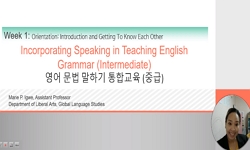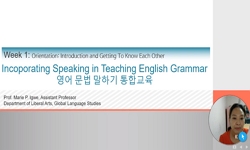The study aimed to determine the outcomes of one teacher’s code-switching between Korean and English in a Teaching English in English (TEE) university class. Seventy-four female freshmen participated in class observations, a survey questionnaire, an...
http://chineseinput.net/에서 pinyin(병음)방식으로 중국어를 변환할 수 있습니다.
변환된 중국어를 복사하여 사용하시면 됩니다.
- 中文 을 입력하시려면 zhongwen을 입력하시고 space를누르시면됩니다.
- 北京 을 입력하시려면 beijing을 입력하시고 space를 누르시면 됩니다.
https://www.riss.kr/link?id=A99564449
- 저자
- 발행기관
- 학술지명
- 권호사항
-
발행연도
2012
-
작성언어
-
- 주제어
-
KDC
373
-
등재정보
KCI등재
-
자료형태
학술저널
- 발행기관 URL
-
수록면
115-141(27쪽)
- 제공처
-
0
상세조회 -
0
다운로드
부가정보
다국어 초록 (Multilingual Abstract)
The study aimed to determine the outcomes of one teacher’s code-switching between Korean and English in a Teaching English in English (TEE) university class. Seventy-four female freshmen participated in class observations, a survey questionnaire, and interviews. The results were categorized into three parts: 1) instances of code-switching, 2) students’ perceptions, and 3) the relationship between code-switching and students’ identity reconstruction. The seven categories of code-switching were: 1) to build rapport between the teacher and students, 2) to assist group discussions, 3) as a repair strategy, 4) to teach bilingual terminology, 5) to disapprove students’ behavior, 6) to announce important notices, and 7) to clarify the meaning of vocabulary. Students had positive perceptions concerning code-switching, in particular, content knowledge delivery and classroom management. More importantly, the teacher’s code-switching influenced the students’ self-identity. This finding implies that code-switching is an effective educational strategy that teachers need to apply based not only on the type of course and the students’ English proficiency levels, but also on the students’ cultural and social context where they construct their identity.
목차 (Table of Contents)
- Ⅰ. INTRODUCTION
- Ⅱ. LITERATURE REVIEW
- Ⅲ. METHOD
- Ⅳ. RESULTS AND DISCUSSION
- Ⅴ. CONCLUSION
- Ⅰ. INTRODUCTION
- Ⅱ. LITERATURE REVIEW
- Ⅲ. METHOD
- Ⅳ. RESULTS AND DISCUSSION
- Ⅴ. CONCLUSION
- REFERENCES
동일학술지(권/호) 다른 논문
-
Readers Theater 활동이 중학생의 영어 읽기와 말하기 능력에 미치는 영향
- 한국영어어문교육학회
- 김소영(Kim, So Young)
- 2012
- KCI등재
-
그래픽 조직자의 활용이 중학생의 영어 듣기 이해와 태도에 미치는 영향
- 한국영어어문교육학회
- 김은수(Kim, Eun-soo)
- 2012
- KCI등재
-
- 한국영어어문교육학회
- 김주혜(Kim, Joohae)
- 2012
- KCI등재
-
- 한국영어어문교육학회
- 박영(Park Young)
- 2012
- KCI등재





 스콜라
스콜라






